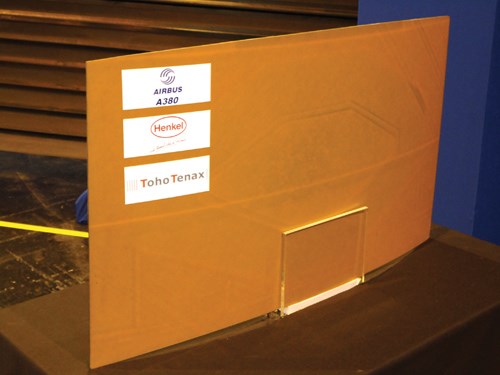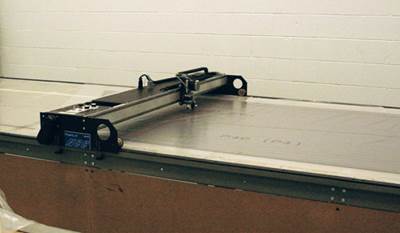JEC Composites Show 2010 Highlights
Despite the volcanic ash that clouded air travel, an eruption of new technology and new business did much to dispel the clouds of economic recession.
The only downside of the 2010 JEC Composites Show (April 13-15, Paris, France) was that an obscure volcano in Iceland belched vast clouds of airborne debris, halting air traffic and marooning many (including five HPC staffers), which kept exhibitors and showgoers from returning home to immediately capitalize on the wealth of new technology and business prospects. Until that unprecedented event, the show itself was a four-day bright spot of activity and energy reminiscent of much better times. Unlike the 2009 show, which at the low point of the recession was only moderately attended, the 2010 event posted a preliminary tally of more than 1,000 participating companies and 27,500 attendees and exhibit personnel, with a more than 30 percent increase in attendance from outside France. Indeed, the level of new product introductions and technical innovation seemed uncommonly robust.
HPC staffers on site at the Paris Expo reported the following during stops on the way to Spain as they rolled south through Europe on trains to Madrid’s open airport after their Paris-to-U.S. flights were canceled. An expansive showcase of news and new products found on the JEC show floor is planned for the HPC July issue.
SGL/BMW forge first link in carbon fiber supply chain
After weeks of speculation, carbon fiber manufacturer SGL Carbon SE (Wiesbaden, Germany) and automaker BMW Group (Munich, Germany) confirmed on April 6 that their joint venture, SGL Automotive Carbon Fibers LLC, has secured a 60-acre site (with an option for 60 additional acres) in Moses Lake, Wash., for a carbon fiber manufacturing plant. Selected, in part, for its proximity to clean, cost-competitive hydropower, the site will support two carbon fiber production lines during its initial $100 million (USD) development phase. The plant’s annual capacity will total 3,000 metric tonnes (6.61 million lb). The fiber will be used exclusively for BMW Group’s Megacity electric-powered urban commuter car, scheduled for launch sometime before 2015 under a BMW sub-brand. The Moses Lake lines will process polyacrylonitrile precursor produced by a joint venture between SGL Group and Mitsubishi Rayon Co. Ltd. (Otake, Japan). The resulting tow will be woven into fabrics at a second joint-venture site in Wackersdorf, Germany. The fabrics will reinforce composites molded at the BMW plant in Landshut, Germany, and finished parts will be shipped to a Megacity vehicle assembly line that will be located in Leipzig, Germany.
The carbon fiber supply chain — the first of its kind in the automotive composites market — will give BMW a reliable source of carbon fiber for the new car, insulating the program from the historic market volatility cited by some automakers as one reason for their reluctance to integrate carbon fiber more widely into production vehicles.
The joint venture’s managing directors, Andreas Wüllner and Jörg Pohlman, sat down with HPC at the show and provided additional details. Noting that their 60-acre plot allows much room for expansion, they hinted that additional lines will be added as demand increases. “All partners have committed to a growth pattern so that if the car is successful, we can increase capacity quickly,” said Wüllner. Although speculation was that the Megacity will be based on BMW’s Mini design, Wüllner and Pohlman said this is not the case. BMW did build several all-electric developmental versions of the Mini for customer and market testing, but the Megacity will be an entirely new, all-electric, “purpose-designed” car made specifically to incorporate carbon fiber parts, including a carbon-fiber chassis.
For the latter, BMW has developed an out-of-autoclave process, based on resin transfer molding (RTM) that the pair said will enable the automaker to quickly manufacture structures, using preforms assembled from noncrimp carbon fiber fabrics. Although few details were revealed, BMW believes it has cleared the manufacturing cycle-time barrier that for so long has prevented the use of carbon fiber in chassis members of production automobiles. “Had BMW not found a solution,” Wüllner confirmed, “this joint venture would not be possible.”
The consumer price for the Megacity, both men said, is unknown, primarily because electric vehicles (EVs) are not likely to rapidly displace internal combustion engine (ICE) vehicles — EVs, by BMW’s reckoning, will earn only a 5 to 15 percent share of the entire auto market by 2020. The question for now, they said, is What premium will customers pay for a carbon fiber chassis vehicle vs. a traditional steel chassis vehicle? Wüllner suggested that automakers might, at some point in the ICE-to-EV evolution, offer vehicles with a choice of steel or carbon-fiber chassis, with the latter more expensive but lighter, making the car more fuel efficient. SGL Automotive Carbon Fibers hopes to make more design and manufacturing information publicly available by the end of the year.
Award-winning carbon fiber technologies
Gulfstream Aerospace Corp. (Savannah, Ga.), materials suppliers Ticona (Florence, Ky.) and TenCate Advanced Composites (Morgan Hills, Calif. and Nijverdal, The Netherlands) and two other Dutch firms, Fokker Aerostructures BV (Hoogeveen) and KVE Composites Group (The Hague), held a press conference to discuss their revolutionary thermoplastic composite vertical tail rudder for the Gulfstream 650 aircraft. (See first photo, at right, and read about another Gulfstream one-piece tail rudder project in "RTM Showcase ...." under "Editor's Picks," at right).
The winning entry in the JEC Innovation Award’s Aerospace category and the first external carbon/polyphenylene sulfide (PPS) primary aircraft structure to fly, the rudder is made with Ticona’s Fortron PPS resin, which is prepregged by TenCate. The material is ultrasonically welded, using technology developed by KVE, eliminating all metal fasteners. Gulfstream plans to produce 70 to 80 G650 aircraft annually.
A JEC Innovation Award finalist, the nominal 2 ft/0.61m square access panel (see second photo) for the auxiliary power unit (APU) on the Airbus A380 commercial jet may look innocuous, but it represents a potentially significant shift in A380 materials selection. Located in the plane’s rear fuselage section, the APU’s high-heat environment demands a resin that can withstand temperatures as high as 120°C/248°F. Airbus originally picked a Toho Tenax Europe GmbH (Wuppertal, Germany) carbon fiber prepregged with a BMI matrix resin in a honeycomb core sandwich construction. Henkel AG & Co. KGaA (Bay Point, Calif.) approached Airbus with an alternative: Replace the BMI with a less expensive, high-performance benzoxazine resin. Henkel product manager David Leach says the resin has passed fire, smoke and toxicity tests, lays up faster than the BMI-based material and is in the final stages of qualification for use on the Airbus A380.
VISTAGY (Waltham, Mass.) featured a composite gearbox (see final photo, at right) for the Renault F1 race car. Designed with VISTAGY’s FiberSIM software, the gearbox features a cast titanium skeleton joined with 600 individual plies of carbon fiber fabric. The resulting structure is 80 percent composite by volume but only 20 percent by weight. Renault says one of the biggest challenges was in managing the different thermal properties of the carbon fiber and the titanium.
Hexcel (Dublin, Calif.) announced its new HexTow IM10 carbon fiber that it claims is a breakthrough material. The new small-denier fiber, based on Hexcel’s legacy intermediate-modulus fiber technology, exhibits a tensile strength of more than 1,010 ksi and a tensile modulus of 44 Msi, with a tensile strain of 2.1 percent. The company says IM10 provides the highest commercially available tensile strength, which is achieved through a combination of better precursor technology and enhanced methods of fiber processing.
Cytec Engineered Materials (Tempe, Ariz.) showcased its new PRISM EP 2400 liquid infusion resin system. The one-part, toughened, 350°F-/177°C-cure epoxy is targeted to aerospace primary structure and “high-performance industrial” markets, says the company, and it can be used with a wide range of reinforcements. With a novel toughening system and wide processing window, the resin reportedly delivers laminate properties equivalent to Cytec’s 977-2 prepreg performance.
In addition to its toolmaking capabilities, Weber Manufacturing Technologies Inc. (Midland, Ontario, Canada) exhibited nickel vapor deposition (NVD) metal erosion strips that it now produces for the leading edges of jet engine stator blades. The 0.010-inch/0.254-mm thick strips are produced by Weber technicians on an aluminum mandrel and then are bonded onto the composite blades.
Related Content
Combining multifunctional thermoplastic composites, additive manufacturing for next-gen airframe structures
The DOMMINIO project combines AFP with 3D printed gyroid cores, embedded SHM sensors and smart materials for induction-driven disassembly of parts at end of life.
Read MorePlant tour: Spirit AeroSystems, Belfast, Northern Ireland, U.K.
Purpose-built facility employs resin transfer infusion (RTI) and assembly technology to manufacture today’s composite A220 wings, and prepares for future new programs and production ramp-ups.
Read MoreASCEND program update: Designing next-gen, high-rate auto and aerospace composites
GKN Aerospace, McLaren Automotive and U.K.-based partners share goals and progress aiming at high-rate, Industry 4.0-enabled, sustainable materials and processes.
Read MoreNext-generation airship design enabled by modern composites
LTA Research’s proof-of-concept Pathfinder 1 modernizes a fully rigid airship design with a largely carbon fiber composite frame. R&D has already begun on higher volume, more automated manufacturing for the future.
Read MoreRead Next
RTM showcase: One-Piece Rudder
A transatlantic design team uses concurrent engineering to integrate rudder spars, ribs and skins in a single RTM cycle.
Read MoreDeveloping bonded composite repair for ships, offshore units
Bureau Veritas and industry partners issue guidelines and pave the way for certification via StrengthBond Offshore project.
Read More“Structured air” TPS safeguards composite structures
Powered by an 85% air/15% pure polyimide aerogel, Blueshift’s novel material system protects structures during transient thermal events from -200°C to beyond 2400°C for rockets, battery boxes and more.
Read More
























